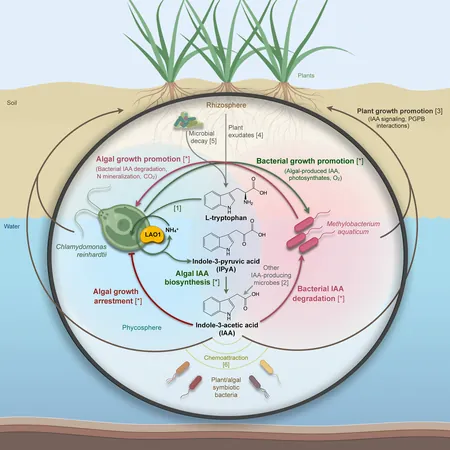
Groundbreaking Study Reveals How Algae Utilize Hormones to Communicate with Bacteria—A Potential Game Changer for Agriculture!
2024-11-26
Author: Nur
Introduction
In an exciting development from the University of Córdoba, researchers have unveiled the mechanisms by which algae produce auxin, a critical plant hormone that facilitates communication not only among plants but also with beneficial bacteria. This discovery, recently published in the journal *iScience*, could pave the way for innovative agricultural practices aimed at enhancing crop production.
The Role of Auxin
Auxin plays a pivotal role in plant growth by directing leaves toward light and roots into the soil. It is an integral part of the chemical signaling pathways that allow plants to interact with a variety of organisms, leading to mutually beneficial relationships. Yet, the specific ways in which algae—considered the ancestral "cousins" of higher plants—produce this hormone had remained largely unexplored until now.
Research Focus
The research team, consisting of Victoria Calatrava, Aurora Galván, Ángel Llamas, and Emilio Fernández, focused their efforts on *Chlamydomonas reinhardtii*, a model algae. They found that the auxin production pathway is remarkably straightforward and common, primarily involving the enzyme L-amino acid oxidase (LAO1), which synthesizes auxin from tryptophan. "This hormone is produced in the algal periplasmic space, a semi-permeable area where it can be released into the environment, allowing for communication with other organisms or integrated back into the alga to regulate metabolic functions," explained Professor Galván.
Algal-Bacterial Dynamics
Interestingly, this study takes a deeper dive into the dynamics between algae and their microbial allies. Findings reveal that while auxin accumulation can inhibit algal growth at high concentrations, low levels of the hormone actually promote growth. Enter *Methylobacterium*—a bacterium that not only interacts with the algae but also plays a crucial role in moderating auxin levels. "This bacterium degrades auxin, thus facilitating continued growth for *Chlamydomonas* while simultaneously feeding on the hormone," noted Calatrava.
Implications for Agriculture
This mutualistic relationship highlights a sophisticated interaction where both algae and bacteria benefit, emphasizing the essential role these microorganisms play in crop ecosystems. The bacteria's capability to utilize auxin specifically in the presence of algae underscores the co-dependence of these organisms.
Future Prospects
The implications of this breakthrough for agriculture are significant. With auxin being a key hormone in enhancing plant growth and stress resistance, understanding its production and regulation in both algae and bacteria could lead to practical applications in crop management. Researchers suggest that these findings could be harnessed to improve agricultural outputs, boosting plant resilience against challenges such as drought.
Conclusion
As the agricultural sector looks for sustainable solutions to increase productivity, this research provides a promising avenue for innovative strategies that could transform crop cultivation. Stay tuned—as we explore more about how nature's intricate relationships could hold the key to feeding the future!

 Brasil (PT)
Brasil (PT)
 Canada (EN)
Canada (EN)
 Chile (ES)
Chile (ES)
 España (ES)
España (ES)
 France (FR)
France (FR)
 Hong Kong (EN)
Hong Kong (EN)
 Italia (IT)
Italia (IT)
 日本 (JA)
日本 (JA)
 Magyarország (HU)
Magyarország (HU)
 Norge (NO)
Norge (NO)
 Polska (PL)
Polska (PL)
 Schweiz (DE)
Schweiz (DE)
 Singapore (EN)
Singapore (EN)
 Sverige (SV)
Sverige (SV)
 Suomi (FI)
Suomi (FI)
 Türkiye (TR)
Türkiye (TR)